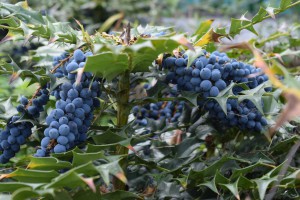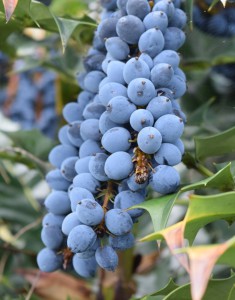Email: geoffdann@hotmail.com
Phone: 07964 569715
19/05/2016
 Oregon Grapes (Mahonia aquifolium) aren’t grapes. They aren’t native to Europe either, coming, as their name implies, from North America, where they are the state plant of Oregon. In the UK they are more often simply referred to by the Latin name “Mahonia”, and they are a very popular ornamental garden plant. Their closest native European relative is Barberry (Berberis vulgaris) – a species that was once common in Britain but was systematically exterminated in many areas because it is a host plant for a fungus that attacks cultivated cereal crops. Oregon Grape produces yellow flowers in spring, but by early summer (i.e. now) these have been replaced by masses of beautiful purple-blue berries. These berries are edible raw, but not particularly impressive. They have large pips, and are rather bitter and tart. They are much better used in jams and jellies, especially to accompany game.
Oregon Grapes (Mahonia aquifolium) aren’t grapes. They aren’t native to Europe either, coming, as their name implies, from North America, where they are the state plant of Oregon. In the UK they are more often simply referred to by the Latin name “Mahonia”, and they are a very popular ornamental garden plant. Their closest native European relative is Barberry (Berberis vulgaris) – a species that was once common in Britain but was systematically exterminated in many areas because it is a host plant for a fungus that attacks cultivated cereal crops. Oregon Grape produces yellow flowers in spring, but by early summer (i.e. now) these have been replaced by masses of beautiful purple-blue berries. These berries are edible raw, but not particularly impressive. They have large pips, and are rather bitter and tart. They are much better used in jams and jellies, especially to accompany game.
 Oregon Grape jelly is very easy to make. First collect plenty of berries. This is quite simple, because they hang in long clusters and easily detach. Although you do need to watch out for the spiky, holly-like leaves and the juice stains everything seriously purple (so wear rubber gloves if you don’t want to stain your hands, and don’t wear your best clothes). When you get them home, rinse the berries to get rid of any debris. The only other ingredients required are sugar and water, and you need a berries/sugar/water ratio of 3/1/1 by volume. Oregon Grape has a high natural pectin content, so you don’t need to add any extra, although there are variations on this jelly that include other ingredients such as lemon juice and ginger. Bring the water to the boil in a saucepan, then add the sugar and berries and boil gently for 20 minutes covered, mashing a couple of times. Uncover, raise the heat a little and boil for a final five minutes. Then strain through a sieve, using the back of a spoon to get as much of the juice and pulp through as possible, while leaving the pips and the skin in the sieve. Or you can use a food mill.
Oregon Grape jelly is very easy to make. First collect plenty of berries. This is quite simple, because they hang in long clusters and easily detach. Although you do need to watch out for the spiky, holly-like leaves and the juice stains everything seriously purple (so wear rubber gloves if you don’t want to stain your hands, and don’t wear your best clothes). When you get them home, rinse the berries to get rid of any debris. The only other ingredients required are sugar and water, and you need a berries/sugar/water ratio of 3/1/1 by volume. Oregon Grape has a high natural pectin content, so you don’t need to add any extra, although there are variations on this jelly that include other ingredients such as lemon juice and ginger. Bring the water to the boil in a saucepan, then add the sugar and berries and boil gently for 20 minutes covered, mashing a couple of times. Uncover, raise the heat a little and boil for a final five minutes. Then strain through a sieve, using the back of a spoon to get as much of the juice and pulp through as possible, while leaving the pips and the skin in the sieve. Or you can use a food mill.
And that’s it! As it cools it will set firmly, and it is ready to be served with venison, turkey or other strong-tasting meats. (If it doesn’t set well, you can always return it to the saucepan and boil for another few minutes to reduce the water content, then leave to set again.)
